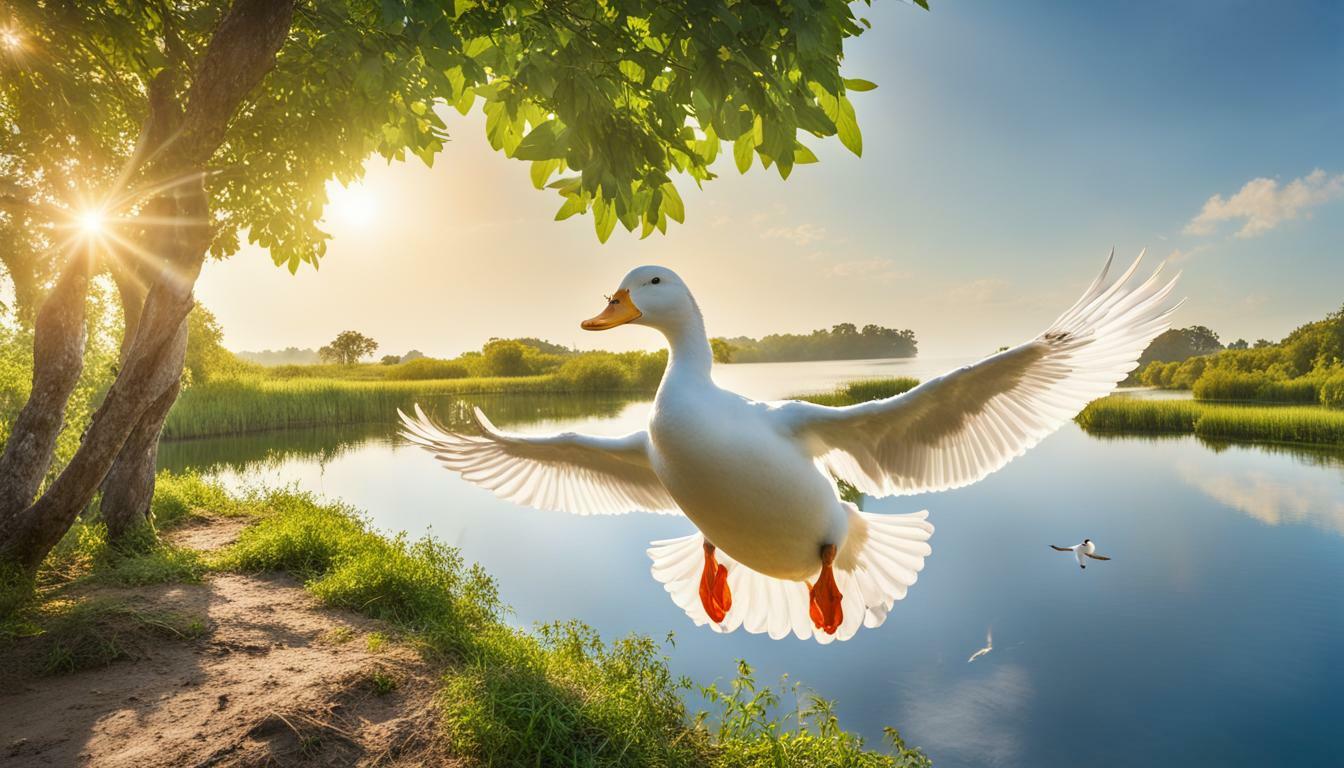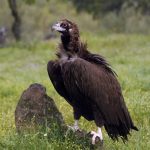Have you ever wondered whether pet ducks can fly? This is a common question among people who keep ducks as pets or are considering doing so. The answer is not straightforward and depends on various factors. In this section, we will explore the factors that influence the flying ability of domesticated ducks, dispelling any confusion surrounding this topic.
While some domesticated ducks can fly to a certain extent, others have lost their ability to fly entirely. Factors such as genetics, breed, and living conditions play a significant role in determining a duck’s flying capability. Domesticated ducks have undergone certain changes due to selective breeding and living in captivity, which affects their biomechanics and overall physical fitness.
Key Takeaways:
- Whether pet ducks can fly depends on various factors such as genetics, breed, and living conditions.
- Domesticated ducks have undergone changes due to selective breeding and captivity, which affects their flying ability.
- Some domesticated duck breeds have lost their ability to fly entirely.
Understanding the Natural Flying Capability of Ducks
When it comes to the question of whether domesticated ducks can fly, it is important to first understand the natural flying capabilities of ducks in general. In the wild, ducks are known for their incredible flying skills and have been observed flying at impressive speeds and heights.
The ability to fly is an inherent part of a duck’s biology, as their wings are specially adapted for flight. The unique shape and structure of their wings, coupled with their lightweight bodies, allow them to move through the air with ease. Additionally, ducks have strong chest muscles that aid in powering their wings.
While some domesticated ducks may still possess the ability to fly to a certain extent, their flying capabilities may be hindered by factors such as lack of exercise and a more sedentary lifestyle. Unlike their wild counterparts, many domesticated ducks live in environments that do not offer opportunities for extended flights, leading to weaker flight muscles and less stamina in the air.
Migration Patterns
In the wild, ducks are known for their impressive migration patterns, which can take them across great distances. This ability is due to their natural flying capabilities, which allow them to fly for long periods of time without tiring. Domesticated ducks, on the other hand, are not typically bred for their migratory abilities and are less likely to possess the stamina needed for long-distance flights.
Overall, while domesticated ducks may still possess some level of flying ability, it is usually not as pronounced as that of their wild counterparts due to factors such as lack of exercise and selective breeding for traits other than flight.
Differences Between Wild Ducks and Domesticated Ducks
While all ducks are born with the ability to fly, domestication has brought about certain changes that affect their natural flying capability. Unlike their wild counterparts, domesticated ducks have been selectively bred over generations for traits such as increased meat and egg production, and as a result, some breeds have lost their ability to fly altogether.
One significant factor that differentiates domesticated ducks from wild ducks when it comes to flight is their lifestyle. Wild ducks are highly migratory and cover vast distances during their annual migrations. This constant movement and exercise strengthen their wings and enable them to fly for extended periods. Domesticated ducks, on the other hand, often live a sedentary lifestyle in pens or enclosures, limiting their opportunities for exercise and flight.
Another important aspect that affects their flying ability is genetic alteration. The selective breeding of domesticated ducks has led to significant changes in their anatomy, including their wing structure. Some domesticated duck breeds may have shorter or weaker wings, making it challenging for them to fly long distances or gain significant altitude.
Finally, living conditions play a crucial role in the flying capability of pet ducks. Factors like inadequate living space, unsuitable diet, and lack of exercise opportunities can further diminish their ability to take flight.
Therefore, it is essential for potential duck owners to research their desired breeds and understand their flying capabilities before making a decision. Providing a suitable living environment with adequate space, access to water, and opportunities for exercise can help promote healthy flight behavior in pet ducks.
Flightless Duck Breeds: Can They Fly?
While ducks are generally known for their ability to fly, not all domesticated duck breeds possess this capability. Certain breeds have undergone selective breeding over time, resulting in genetic alterations that make them flightless. This section will explore flightless duck breeds and the reasons why they are unable to fly.
| Breed | Flying Ability | Reasons for Flightlessness |
|---|---|---|
| Muscovy | Minimal | Muscovy ducks have heavier bodies and shorter wings than other breeds, making it difficult for them to take flight. They also prefer to walk and swim instead of flying. |
| Pekin | Flightless | Pekin ducks have been selectively bred for their large size and meat production, resulting in a heavy body that makes flying impossible. Their wings have also been altered to be shorter and less effective for flight. |
| Rouen | Minimal | Rouen ducks are a larger and heavier version of Mallard ducks. While they are capable of short flights, their body weight and size make it difficult for them to fly long distances. |
It is important for potential duck owners to research the specific breed they are interested in and understand their natural flying ability. While flightless duck breeds can still make great pets, owners must be aware of their limitations and provide appropriate living conditions and care.
Flying Ducks as Pets: Factors to Consider
When considering keeping ducks as pets, their flying capability is an important factor to keep in mind. While some duck breeds may possess the ability to fly, others may not due to selective breeding and domestication.
It’s important to research the specific breed of duck you’re interested in and understand their natural flying capability. This will help you provide a suitable environment that encourages healthy flying behavior.
Factors that may affect a pet duck’s flying ability include their diet, exercise routine, living conditions, and overall health. Providing a balanced diet and plenty of opportunities for exercise, such as access to a pond or pool to swim, can help keep their wings strong and promote healthy flying behavior.
It’s also important to provide a safe and secure environment for your pet duck. A fenced-in yard or enclosure can prevent them from flying away and protect them from potential predators.
If your pet duck is a breed that possesses the ability to fly, it’s important to train them properly to prevent them from flying away. Gradually introducing them to flight in a controlled environment, such as with a harness or within a large enclosed area, can help them develop their flying skills and bond with their owner.
Overall, whether your pet duck can fly or not, providing a safe and enriching environment can help promote their natural instincts and overall well-being.
Flying Ducks as Pets: Factors to Consider
As a potential duck owner, understanding the flying capability of your pet is important. While some domesticated ducks retain their ability to fly, others have become flightless due to selective breeding over time. Here are some factors to consider:
Genetic traits and breed
The ability to fly depends on the breed of the duck. While some breeds such as Muscovy ducks can fly, others like Pekin ducks have lost their ability to fly over time due to selective breeding. It is important to research the specific breed you wish to keep and understand their natural flying capability before making a decision.
Living conditions
The environment in which you keep your ducks can significantly impact their flying ability. Domesticated ducks may have become accustomed to a sedentary lifestyle, particularly if they are kept in small enclosures. Providing ample space for your ducks to move around and explore will encourage them to fly and exercise their wings.
Feeding and nutrition
Feeding your ducks a balanced and nutritious diet can help promote their physical health and overall well-being. A diet lacking in essential nutrients can affect their ability to fly and may lead to other health issues.
Encouraging healthy flying behavior
Creating a stimulating and enriching environment for your ducks can encourage healthy flying habits. Providing access to water, toys, and other forms of entertainment will allow them to engage in natural activities and promote their physical development.
In conclusion, the flying capability of pet ducks is determined by a combination of genetic traits, breed, living conditions, and diet. Understanding these factors is crucial when deciding whether to keep ducks as pets and providing a suitable environment for them. Whether your ducks can fly or not, promoting healthy flying habits is an important aspect of their well-being.
What Factors Can Influence Whether or Not a Pet Duck Will Fly Away?
Factors such as breed, age, wing health, and enclosure design can impact whether pet ducks and flying go hand in hand. While some breeds are better fliers than others, young and healthy ducks generally retain the instinct to fly. Ensuring secure enclosures and providing opportunities for flight exercises can prevent pet ducks from taking off.
FAQ
Q: Can pet ducks fly?
A: The flying ability of pet ducks can vary depending on factors such as breed and living conditions. Some domesticated ducks may retain their ability to fly to a certain extent, while others have become flightless due to selective breeding.
Q: What factors influence the flying capability of pet ducks?
A: The flying capability of pet ducks is influenced by various factors, including their genetic traits, breed, and living conditions. Certain breeds are more likely to retain their ability to fly, while others have lost this ability through selective breeding.
Q: How can I create a suitable environment for flying ducks?
A: To promote healthy flying behavior in pet ducks, it is important to provide a safe and enriching environment. This can include ensuring ample space for exercise, providing access to water for swimming and bathing, and offering a balanced diet to support their physical well-being.
Q: Are there flightless duck breeds?
A: Yes, there are certain domesticated duck breeds that have lost their ability to fly entirely. These flightless duck breeds have been selectively bred for specific traits and no longer possess the necessary wing structure or muscle development for sustained flight.
Q: What should I consider if I want a flying duck as a pet?
A: If you are interested in owning a flying duck as a pet, factors to consider include the breed’s natural flying capability, their need for adequate space, and the availability of suitable living conditions. It is important to research the specific breed and understand their flying habits before making a decision.










